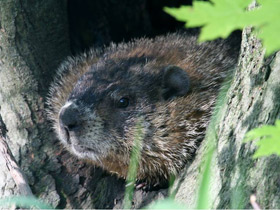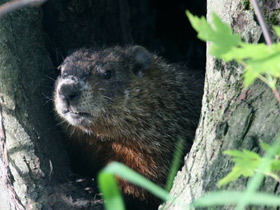The Groundhog (Marmota monax) or woodchuck
Distribution and external features
The Groundhog (Marmota monax), also known as a woodchuck. It is this groundhog that we know well from the well-known film "Groundhog Day". The body length of this cute rodent reaches 32-40 cm, tail length 10-15 cm, weight ranges from 4.5 to 6.3 kg. Its fur is coarse-haired, reddish or reddish-brown almost over the entire surface, with a patina of grey from the light tips of the spinous hairs. The head and cheeks are dark, with a white spot near the nose; the underside is lighter; the paws are black or almost black. Young animals are less brightly coloured. The woodchuck is distributed from eastern Alaska, Yukon, and British Columbia across southern Canada to the Atlantic coast of the United States south to Arkansas, Alabama, and South Carolina; it is also found in eastern Labrador. It is the most widely distributed species of American marmot.
Habitat, lifestyle and habits
Unlike most other marmot species that inhabit mountainous terrain, the woodchuck prefers flatlands. Within its range, Marmota monax settles in lowland forested regions, preferring to occupy wooded areas for hibernation and open areas for foraging and breeding. Deforestation and land reclamation in general benefit this species, as marmots often settle on cultivated land interspersed with grassy pastures and small patches of forest or tree plantations. They are found on dry, sandy loam and light loamy soils in lightened forests, in forest glades and edges, in bushes and greenery, along the banks of water bodies, in overgrown ravines, in pastures and near agricultural fields. Found in forests of various types, including coniferous forests. Unlike other North American species, the woodchuck does not settle in upland areas.
The dwelling place of woodchucks is burrows
These animals rarely move far from shelters. Burrows, especially wintering burrows, are built on well-drained areas warmed by the sun, often on hillsides; summer burrows are usually located on open, flat areas, including fields.
Marmota monax burrows have from 1 to 11 exits; the main entrance is usually easily visible due to discarded earth and stones. Side entrances are smaller in diameter and better camouflaged; they may appear as nearly vertical passages connected to the main tunnel. In the permanent burrow of Marmota monax, tunnels lead to a nesting chamber (up to 45 cm in diameter) lined with dry leaves and grass, which is usually located at a depth of up to 1.8 metres. Specialised cleaning chambers are also available. The total length of tunnels may reach 15 m. There may be up to 8 dens in the territory occupied by an adult marmot.
Marmota monax habitat areas are usually small, less than 2 hectares in area; plots of sedentary males often cover winter hibernation sites of 1-3 adult females, but do not overlap with plots of other males.
Social behaviour
Marmota monax are solitary and territorial; they occur in pairs and groups only during the breeding season. Very rarely one burrow is occupied by a male-female pair. Of all marmot species Marmota monax behave most aggressively towards relatives, including sexually mature females towards other females.
Adults are usually sedentary, although they may change foraging areas when necessary; young males usually roam from place to place.
Marmota monax living in adjacent areas establish a dominance hierarchy among themselves. Interestingly, Marmota monax burrows provide shelter for many species of animals, snakes and birds. Their empty burrows are occupied by river otters, chipmunks, voles, rodents, house mice and white-footed hamsters. Rabbits, opossums, raccoons and skunks may even overwinter in the same burrow as hibernating Marmota monax.
Marmota monax are active primarily during the day, although they can be observed at dusk and even at night. In early spring and autumn before hibernation, their main peak of activity is at midday; in summer, the peak of activity shifts to the morning and late afternoon. To communicate, Marmota monax usually use a characteristic shrill whistle, audible at a distance of 200-300 metres. Less often they emit a muffled bark; during fights with congeners they squeal. When on the surface, they often assume a posture in a column; this behaviour is observed in young Marmota monax from the 37th day of life. When threatened, Marmota monax hide in the nearest burrow; they usually move at a speed of no more than 3 km/h, but can reach speeds of up to 16 km/h when threatened. When unable to flee, Marmota monax defend themselves aggressively with their teeth and front claws.
What the woodchuck feeds on
The Marmota monax feeds on vegetative parts of plants. Feeding usually takes place on the ground, although woodchucks may climb trees or swim across water bodies in search of food. The diet of Marmota monax includes leaves, flowering plants (plantain, dandelion), herbs and cereals; the composition of the diet varies depending on seasonal and local food availability and individual preferences. Marmota monax occasionally eat invertebrates such as molluscs, beetles and grasshoppers. In early spring, when green vegetation is sparse, Marmota monax may feed on bark, buds and shoots, including those of fruit trees and shrubs. Because alfalfa and clover are the preferred food of marmots, marmots frequent fields sown with them; they also eat vegetable legumes. Marmota monax obtains water mainly from eating vegetation or from morning dew.
Winter hibernation in Marmota monax
Marmota monax do not store food, but by autumn they become very fattened, accumulating fat. For hibernation marmots move to wooded areas, to stony slopes, sometimes they hibernate in stacks. Hibernation of Marmota monax is not as deep as in other marmot species - 4-10 days of hibernation are interrupted by 1-5 days of wakefulness, although sleep periods gradually lengthen. Hibernation usually lasts from October to March-April; in warm winters in the south of their range, marmots awaken as early as early February. During hibernation, the metabolic processes of Marmota monax are suppressed: the number of heartbeats drops from 100 to 10-15 beats/minute, body temperature decreases to 8 ˚C, and respiration rate also decreases markedly.
Reproduction
Males are the first to emerge from hibernation, sometimes as early as February. From early March to late April, males roam in search of females, clashing with each other or defending their habitat from competitors. Males probably mate with several females. In some parts of the range, an established pair remains in a common burrow throughout the female's pregnancy. Pregnancy lasts 31-32 days. The female gives birth to an average of 4 (2 to 7) cubs once a year; births occur in the brood burrow. Cubs are born in April - May, naked, deaf and blind, weighing 26-27 g with a body length of about 10 cm. During the first week its skin acquires pigment colouring; in the second week short black hair appears on the body; eyes open on the 26th-28th day, at the same time cubs begin to switch to solid food. The hair coat is well developed by one month of age. Milk feeding lasts up to 44 days. Males do not take part in caring for the offspring. By 6-7 weeks young marmots begin to disperse; initially they dig temporary burrows close to the brood burrow, but over time they move further and further away from it. Sexual maturation in marmots occurs after the first hibernation. In nature, woodchucks live for 4-6 years; the maximum known age in captivity is 14 years.
Relationship with humans
Both their diet and their habit of burrowing make groundhogs serious nuisance animals around farms and gardens. They will eat many commonly grown vegetables. Extensive burrowing can undermine foundations.
Very often, the dens of groundhogs provide homes for other animals, including skunks, red foxes, and cottontail rabbits. Foxes and skunks feed upon field mice, grasshoppers, beetles, and other creatures that destroy farm crops. In aiding these animals, the groundhog indirectly helps the farmer. In addition to providing homes for itself and other animals, the groundhog aids in soil improvement by bringing subsoil to the surface. The groundhog is also a valuable game animal and is considered a difficult sport when hunted in a fair manner. In some parts of the U.S., they have been eaten.
Survival
In the wild, groundhogs can live up to six years with two or three being average. In captivity, groundhogs reportedly live up to 14 years. Human development, which often produces openings juxtaposed with second growth trees that are incidentally also favored by groundhogs, often ensures that groundhogs in well-developed areas are nearly free of predators, beyond humans (through various forms of pest control or roadkills) or mid-to-large sized dogs.
Subspecies
Se conocen cuatro subespecies de Marmota monax:
- Marmota monax monax - Linnaeus, 1758;
- Marmota monax canadensis - Erxleben, 1777;
- Marmota monax ignava - Bangs, 1899;
- Marmota monax rufescens - A. H. Howell, 1914.

















































